- Utilizing waste zirconia nozzles for eco-friendly ceramic tile production
Zahide Bayer Ozturka,*, Yusuf Karacab, Semra Kuramac, Elif Ubayb and Ugur Cengizd
aDepartment of Metallurgy and Materials Engineering, Nevsehir Haci Bektas Veli University, 50300, Nevsehir, Turkey
bSeranit Granite Ceramic Company, R&D Center, Bilecik, Turkey
cDepartment of Materials Science Engineering, Eskisehir Technical University, 26555, Eskisehir, Turkey
dBilecik Iron Steel Industy, Bilecik, TurkeyThis article is an open access article distributed under the terms of the Creative Commons Attribution Non-Commercial License (http://creativecommons.org/licenses/by-nc/4.0) which permits unrestricted non-commercial use, distribution, and reproduction in any medium, provided the original work is properly cited.
The ceramic industry is increasingly focused on sustainability, seeking alternatives to reduce the environmental impact of raw material extraction and consumption. Recycling initiatives and waste reduction strategies have proven essential in conserving resources and minimizing waste. Zirconia nozzles, commonly used in continuous steel casting for molten metal flow control, are typically made from high-purity zirconia powder. Despite their critical industrial role, waste zirconia nozzles remain an underutilized source of zircon oxide, a valuable and costly raw material used in white floor and porcelain tile production. This study explores the potential of repurposing waste zirconia nozzles from the Iron Steel Company (Bilecik, Turkey) for ceramic tile manufacturing. Comparative analysis of color properties between standard zircon and waste zirconia materials was conducted, followed by extensive physical and mechanical assessments of the final tile products. Crystal-phase analysis (XRD), chemical composition analysis (XRF), and microstructural evaluation (SEM-EDS) were performed to evaluate the feasibility of this sustainable approach. The results demonstrate the viability of using waste zirconia nozzles as a cost-effective, environmentally responsible alternative in ceramic tile production without compromising product quality. This study highlights the potential for significant waste reduction and cost savings in the ceramic industry.
Keywords: Ceramic tile, Zircon, Nozzle waste, Recycling, Color property.
Ceramic tiles are versatile and widely used building materials known for their durability, aesthetic appeal, and practicality [1, 2]. These tiles have a long history dating back to ancient civilizations, and they continue to be a popular choice in modern construction and interior design [3]. The production of ceramic tiles is a complex process that involves various natural raw materials, each playing a crucial role in the final product's quality and characteristics. These raw materials are carefully selected and processed to create ceramic tiles that meet specific standards and fulfill various functional and aesthetic requirements [4]. Ceramic tiles are heterogeneous materials, composed essentially of clays and other inorganic raw materials such as quartz, feldspar, and carbonates. The clays are the most important component of ceramic tiles, but other materials are added to improve the tiles' properties and characteristics [5-7]. The specific raw materials and their proportions can vary depending on the type of ceramic tile being produced (e.g., porcelain, ceramic, terracotta) and the desired characteristics of the final product. Producers carefully select and blend these raw materials to meet quality standards, achieve the desired aesthetic effects, and ensure the tiles' performance in various applications [8]. The chemical and mineralogical composition of raw materials, along with firing conditions (temperature, time, rate, and atmosphere), are key factors influencing the technological properties of ceramic bodies [9, 10].
Efforts are ongoing in the ceramic tile industry to explore sustainable alternatives and reduce the environmental impact of raw material extraction and use. Recycling and waste reduction programs have been instrumental in alleviating resource depletion and waste accumulation [11-13]. In light of mounting environmental concerns, the ceramic tile industry is actively engaged in the pursuit of sustainable practices. A primary focus lies in curbing the environmental impact linked to the extraction and utilization of natural raw materials [14-16].
The use of industrial wastes as a raw material in ceramic tile compositions presents an effective and sustainable solution for reducing waste [17]. There are many studies in the literature dealing with the use of industrial wastes in the composition of ceramic tiles. Granite wastes [18], shards of glass [19], different slags [20-22], boron wastes [23], waste clays [24], various ashes [21, 25] are some examples of industrial wastes that have been used in ceramic tile compositions.
Zirconia nozzles are a type of ceramic nozzle used in various industrial applications. Zirconia nozzles are manufactured using a variety of techniques, including additive manufacturing and direct ink writing [26]. The manufacturing process involves the use of high-purity zirconia powder, which is shaped into the desired nozzle shape and then sintered at high temperatures to achieve the desired properties [27]. Zirconia nozzles are used in the continuous casting of steel as a tundish refractory [28, 29]. In the iron and steel industry, molten liquid metal is transported through ladles and undergoes a number of metallurgical processes at various stations such as ladle furnaces or converters. The liquid metal is sent to the continuous caster for conversion into semi-finished or finished products. In the ladle, the liquid metal is shaped by means of a tundish through open-bottomed copper moulds. In order to control parameters such as product quality, planning of production processes, casting speed, etc., it is important to control the flow of liquid metal flowing from the tundish to the copper mould. Flow control systems are needed under the tundish. These systems include one fixed zirconia nozzle and one replaceable zirconia nozzle. These nozzles are separated by taking waste by exchange and disposable method in order to ensure production depending on the relevant parameters [30]. There are limited studies in the literature on the use of zirconia nozzle wastes resulting from production in iron and steel factories. However, the evaluation of this waste as a zircon alternative in the wall tile glaze recipe has been investigated [30]. Some studies have investigated the corrosion behavior of zirconia metering nozzles after service in a tundish for continuous steel casting [31]. Overall, while there are limited studies on the use of zirconia nozzle wastes in ceramic tile compositions, there is potential for this waste to be an important source of zircon oxide. Further research is needed to explore the feasibility and effectiveness of using zirconia nozzle wastes as a zircon alternative in ceramic tile compositions.
In the production of white floor and porcelain tiles, zircon (ZrSiO4) is often incorporated as a whitening agent and it is a pricey raw material. Since zircon is typically imported, it contributes to production costs and is susceptible to market speculation, resulting in price fluctuations [32]. The ceramics industry represents the largest zircon market in terms of volume, consuming more than 50% of the global zircon production. Although approximately 85% of zircon used in the ceramics sector is dedicated to tile manufacturing, zircon also plays a significant role in the realm of advanced ceramics. Zircon is generally used in ceramic glazes due to provide highly mechanical and chemical resistance to the surface of the product. To enhance the chemical resistance of zircon-containing glazes, it is advisable to prevent the integration of ZrO2 into the glassy phase [33, 34]. The objective of this study is to assess the potential utilization of zirconia nozzle waste within the ceramic coating industry. This aims to enable the production of white floor tiles, typically reliant on costly raw materials like zircon, by integrating the recycling of valuable waste into the production process. Ultimately, this approach seeks to reduce waste generation while maintaining product quality.
The study explored the feasibility of utilizing waste zirconia nozzles provided by Bilecik Iron and Steel Company (Bilecik, Turkey) in the production of floor tiles. This research comprised experimental investigations and analyses, including a comparative assessment of the color properties of standard zircon raw materials used in the formulation versus waste zirconia. Various combinations of waste zirconia were incorporated into the ceramic tile recipe of Seranit Granit Seramik (Bilecik, Turkey) utilizing raw materials known for their distinctive color characteristics. After undergoing the necessary processing steps, the formulated recipes were fired in an industrial kiln and subsequently subjected to initial physical and mechanical evaluations. Further analyses encompassed crystal phase analysis using XRD (Rigaku Miniflex 600 series diffractometer, Ɵ: 5 to 70⁰, at a scanning speed of 2⁰/min, with Cu Kα radiation at 40 kV and 30 mA.), chemical analysis conducted with XRF (Rigaku ZSX Primus model), and microstructural examination utilizing SEM-EDS (Zeiss EVO model).
Preperation of raw materials
Initially, the supplied zirconia nozzles underwent a procedure to eliminate any iron components attached to them. This purification process involved the meticulous removal of iron fragments from the primary material, achieved with the assistance of a diamond cutter. Subsequently, the waste zirconia nozzles (WZ), having undergone mechanical separation and purification, were further processed by crushing them using a jaw crusher to reduce their grain sizes. The entire preparation sequence for the waste zirconia nozzles is illustrated in Fig. 1.
Preperation of samples
The specified formulations are detailed in Table 1. These formulations were processed in a ball mill for a duration of 35 minutes and subsequently dried in an oven at 100 °C. The dried clay mixtures, adjusted to contain 5 wt. moisture, were then pressed at 150 bar into dimensions measuring 5 × 5 × 10 cm and fired at 1212 °C/50 min. within an industrial roller kiln. Following the firing process, the resulting compositions underwent comprehensive physical and mechanical analyses. The prepared tiles were shown in Fig. 2.
Prior to the formulation of the recipes outlined in Table 2, a comprehensive evaluation was conducted using the SEGER formula, aligning with established factory standards. In light of the considerable expense associated with standard zirconia, the decision was made to incorporate WZ as an alternative. Initially, formulations labeled as D1 and D2 were created as part of this endeavor. Subsequently, formulations labeled as D3, D4, and D5 were developed based on insights derived from previous formulation studies. In these formulations, the quartz was added to recipes for reduce the deviation in firing shrinkage. The viscosity, density, and sieve residues assessments were applied to samples. After the firing process, comprehensive analyses were carried out on the resulting plates, including assessments of fracture strength, bending strength, firing shrinkage, L*-a*-b* values, and water absorption properties. The colorimeter employs the CIELab method, a widely employed technique in ceramic production, to assess the whiteness and color characteristics of tiles. This method measures three key parameters, referred to as Hunter parameters: L* (brightness) ranging from absolute white at L 100 to absolute black at L 0, as well as a* (red–green) and b* (yellow–blue), which are derived from the visible spectrum [32].
The gathered results were meticulously scrutinized, and further investigations were conducted, focusing on crystal phase composition and microstructural characteristics, particularly in the samples that exhibited the closest resemblance to the standard floor tile sample.

|
Fig. 1 The preperation of zirconia nozzles for ceramic tile compositions. |
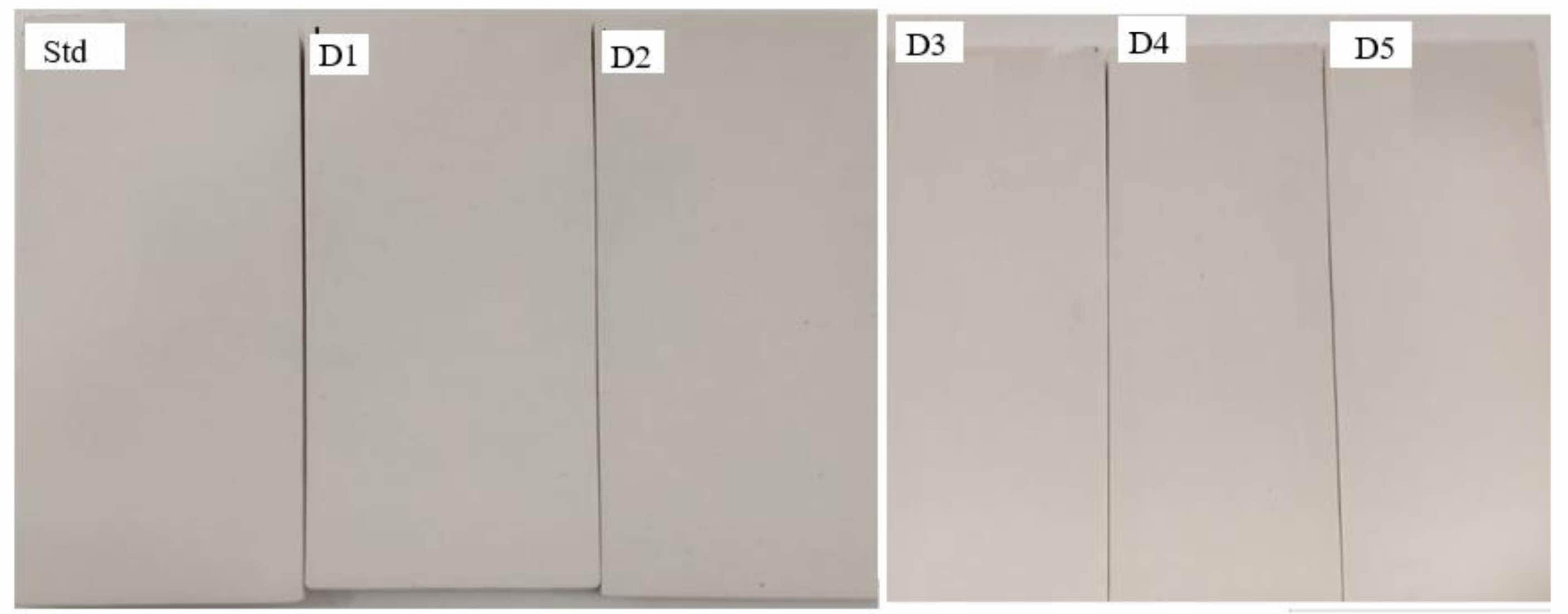
|
Fig. 2 Fired tile samples. |
The chemical analysis of both the used zircon and WZ is presented in the Table 2. Upon closer examination of the analysis results, it becomes evident that zirconia nozzle wastes exhibit significantly higher levels of ZrO2 and HfO2 content, while simultaneously displaying considerably lower levels of SiO2 content when compared to standard zircon raw material. Verified through chemical analysis, the phase analysis of the zircon raw material conclusively identified the presence of the zircon phase. Conversely, in the crystal phase analysis of the waste material, both baddeleyite and HfO2 phases were unequivocally detected in Fig. 3.
In each of the formulated recipes, three plates were subjected to pressing: one plate was utilized for the measurement of raw strength, while the remaining two plates were reserved for subsequent post-firing analysis. It is noteworthy that the sludge density across these prepared recipes falls within the range of 1695 to 1720 grams per liter. Furthermore, their viscosity levels fall between 35 to 44 seconds, and their 63-micron sieve residue ranges from 0.25 to 0.43%. The viscosity, density, and sieve residues of the formulations containing both standard floor tile composition and waste material transformed into sludge form have been thoroughly investigated, and the findings are presented in Table 3.
The fired plates from each recipe underwent tests, including fracture strength, , firing colors (L*-a*-b* parameters), firing shrinkage, and water absorption tests, the results of which are presented in Table 4. In contrast, for the raw plates, only breaking load and bending strength tests were conducted.
The strength results of raw and post-fired samples are given in Fig. 4. Upon examination of the results, it can be observed that samples with higher initial strength values have slightly higher firing strength values. It is noteworthy that tiles based on zirconium oxide waste can achieve higher strength than the standard. Even the use of the relevant waste at a rate of 2% can significantly increase the strength results. Due to its high-temperature resistance, zircon oxide finds its place in the ceramic industry with its important properties such as refractory, furnace bricks, and decorative ceramic coatings depending on its optical properties, and high voltage applications depending on its dielectric properties. It can be observed that zircon oxide has a wide range of potential uses in the ceramic sector with these significant features [35]. However, despite its ability to offer these important properties, it is also one of the most expensive materials in the industry. Through the use of waste nozzles as an alternative source of zircon oxide in tile composition, it is anticipated that there will be an increase in strength and even an improvement in wear resistance without significantly altering shrinkage and water absorption properties compared to the standard.
The examination of the floor tile compositions included an assessment of their whiteness. The color parameters (L*, a*, and b*) of all samples were meticulously measured. In Table 4, a comparison of these parameters for white floor tile (STD, D1-D5) is presented. Notably, samples containing WZ (D1-D5) exhibit higher L* values in comparison to the standard tile composition.
The primary reason for the high L* values in samples containing waste zirconium is the interaction of zircon oxide with the glassy phase, leading to a more homogeneous structure, as well as the contribution of varying silica and alkaline components in the chemical composition to the appropriate balancing of the glassy phase. These interactions are believed to enhance the opacity of the samples and consequently increase their L* values.
The raw plates exhibited fracture strength ranging from 3.50 to 5.30 kilograms, while the fired plates displayed fracture strengths within the range of 135 to 150 kilograms. Notably, among the samples, D5 showcased the closest firing shrinkage to the standard tile (7.86), with a value of 7.90, whereas D-3 had the furthest deviation, recording a shrinkage (%) of 7.26. In terms of firing color analysis, the sample coded as D1 closely matched the standard, whereas the furthest departure was observed in the D4. Concerning water absorption, the values across the samples fell within the range of 0.08 to 0.20. The water absorption values of the fired samples approached zero, confirming that the fired body meets the standard criteria for water absorption. Upon examining the flexural strengths following the firing process, it becomes apparent that the D2 sample (76.55 N/mm2) exhibited an increase in flexural strength, while the remaining samples generally yielded similar results. To determine the reason for the high strength results, an analysis of the D2 sample composition revealed that its SiO₂ content is lower and ZrO2 content higher compared to the standard and other formulations. It is known that SiO2 can form hard and brittle phases within the ceramic matrix, leading to crack formation and strength reduction. Microstructural analyses showed that zircon grains are predominant in the D2 sample, while quartz crystals of varying sizes are observed in other samples. Zircon, known for its hardness and chemical stability, is considered to enhance the mechanical strength of the sample [33].
Additionally, the presence of waste zircon contributes to creating a more stable and consistent structure after firing. Therefore, the increased consistency in fracture strength observed after firing is associated with reduced porosity in the composition, stabilization of crystal phases, and the structural homogeneity of the glassy phase.
In the crystal phase analysis of samples containing waste zirconia and standard floor tiles, the detected phases include quartz, albite, and mullite in Figs. 5 and 6. Opacity arises from variations in refractive indices between the glassy matrix and crystalline phases. Achieving opacity hinges on preventing the dissolution of crystals into the glassy matrix during the firing process [36]. Zirconium silicate, boasting a notably high refractive index of 1.94, stands as the most prevalent opacifier. Additionally, mullite (1.64), quartz (1.54), anorthite (1.58) and albite (1.53) [37]. crystal particles dispersed within the glassy phase (with a refractive index of 1.50) constitute fundamental mechanisms for opacification, despite the relatively minor differences in refractive indices between these crystals and the glassy phase [37].
Optimal firing conditions help minimize the formation of the glassy phase while preserving the crystal structures, which will affect opacity. Generally, excessively high temperatures, rapid temperature increases, and prolonged firing times can lead to the dissolution of crystals into the glassy matrix.
Figs. 7 to 11 present secondary electron images and EDX analysis results for both the standard and the selected WZ-based floor tile samples. Upon examination of the SEM images, the needle-shaped crystals identified in the microstructure were identified as primary and secondary mullite crystals rich in Al2O3 and SiO2. In addition to mullite crystals, the samples also exhibited the development of quartz and albite phases. This phenomenon demonstrates that mullite and albite crystals contribute to the whitening of the color, leading to an increase in L* values due to their opacifying effect. While the microstructures of standard and D1 samples are generally similar to each other, residual quartz crystals exceeding 2 µm stand out in D2 and D4 samples in Fig. 7.
Upon examining Fig. 8, it is worth highlighting that the standard sample similarly includes Si, Al, Na and O, and shares the presence of needle-like primary mullites and a glassy phase.
Based on the EDS analysis results shown in Fig. 9 for the D1 code, outcomes closely resembling those of the standard sample were achieved. The microstructure reveals the presence of mullite structures, along with Si, Al, Na, and O content. Upon analysis of Fig. 9, it is evident that the microstructure prominently features secondary and primary mullites, distinguishing it from the standard tile. The EDS analysis revealed a composition of 2.34% Na, 16.99% Al, 34.84% Si, and 35.65% O within the microstructure. Similarly, in the EDS result for sample D4, as shown in Fig. 10, elemental analysis yielded a composition of 1.73% Na, 30.78% Al, 36.82% Si, and 30.66% O. Fig. 11
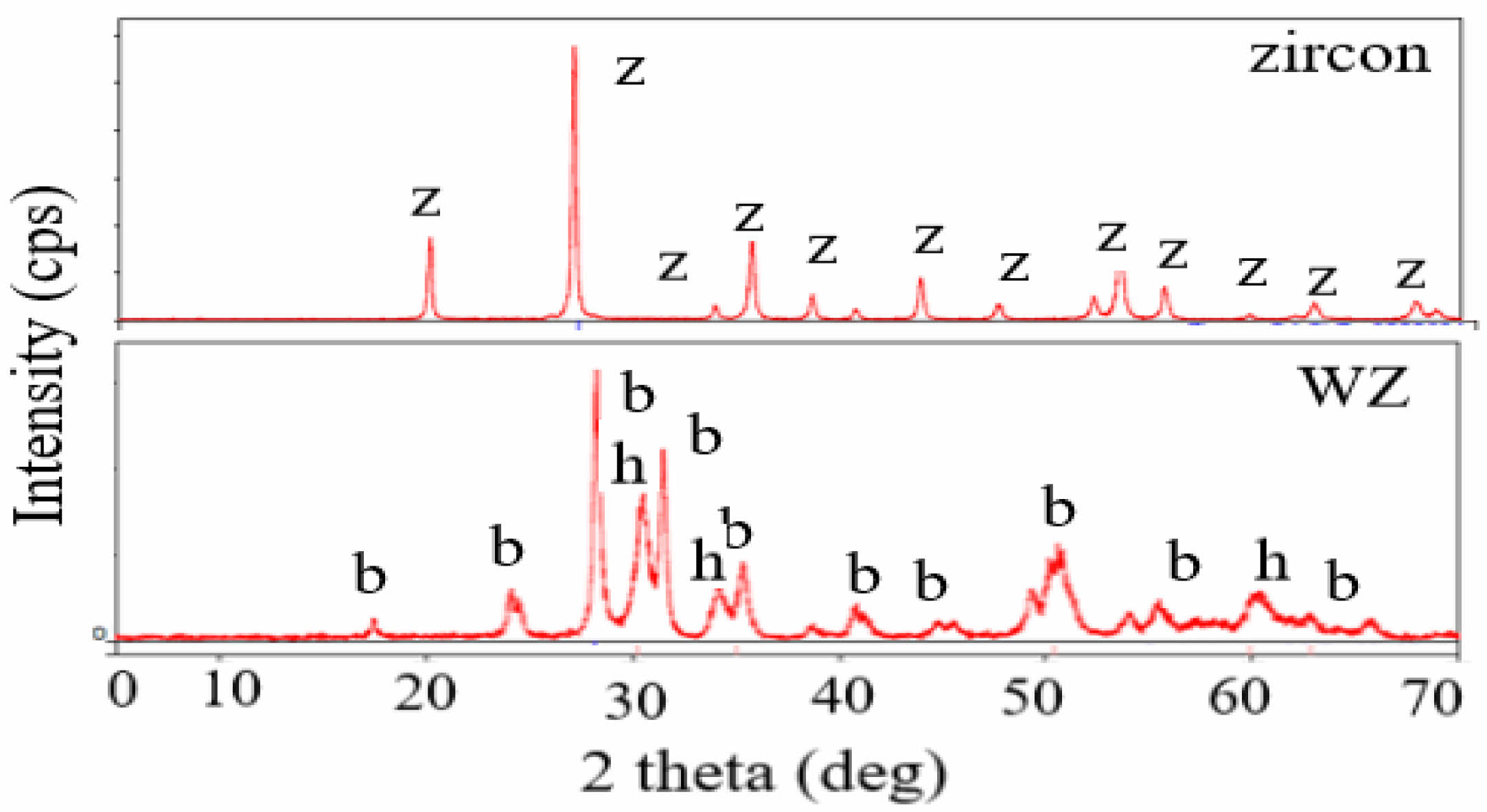
|
Fig. 3 XRD phases of the zircon and WZ (z: zircon, b: baddeleyite, h: HfO2). |
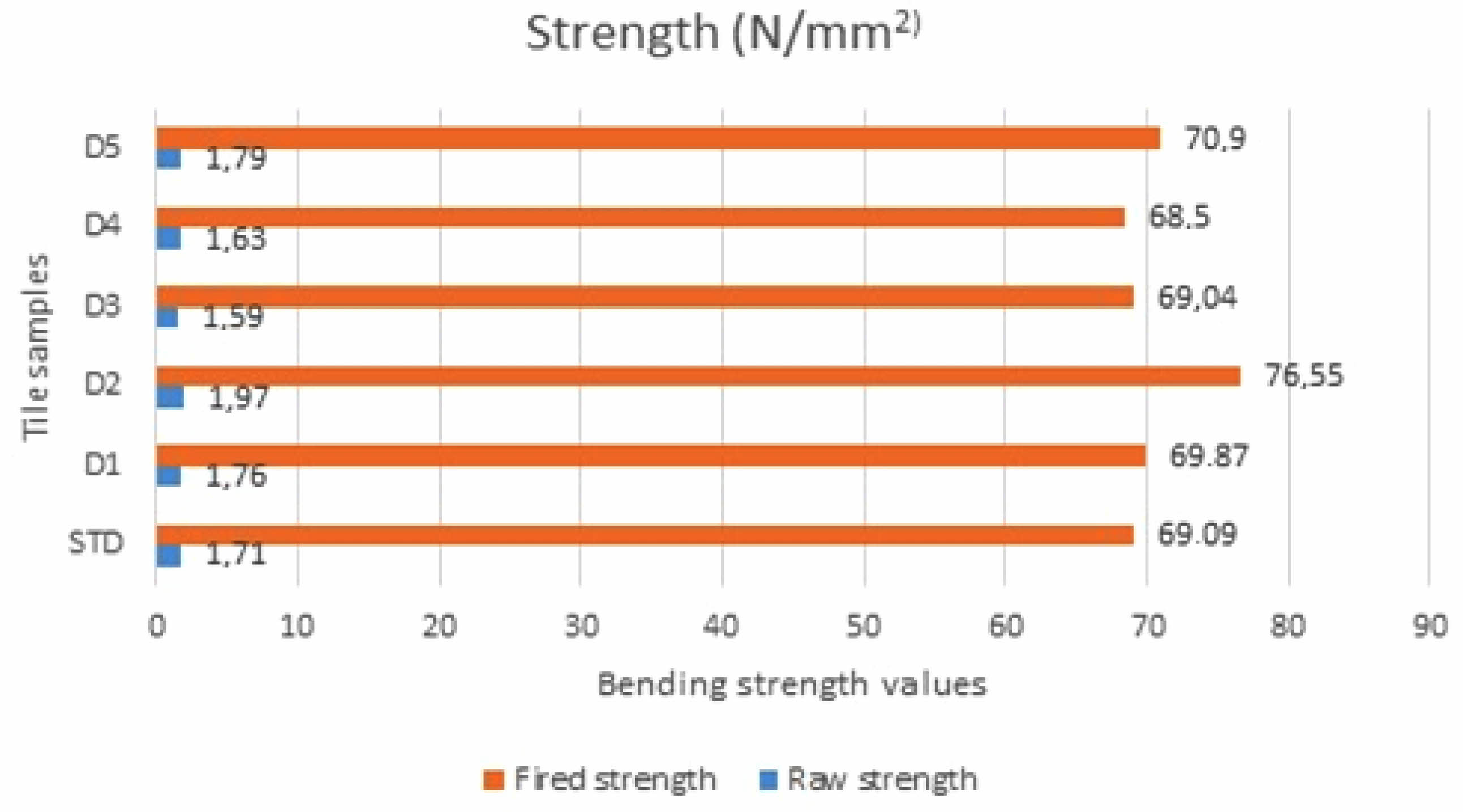
|
Fig. 4 Bending strength results of tile samples |
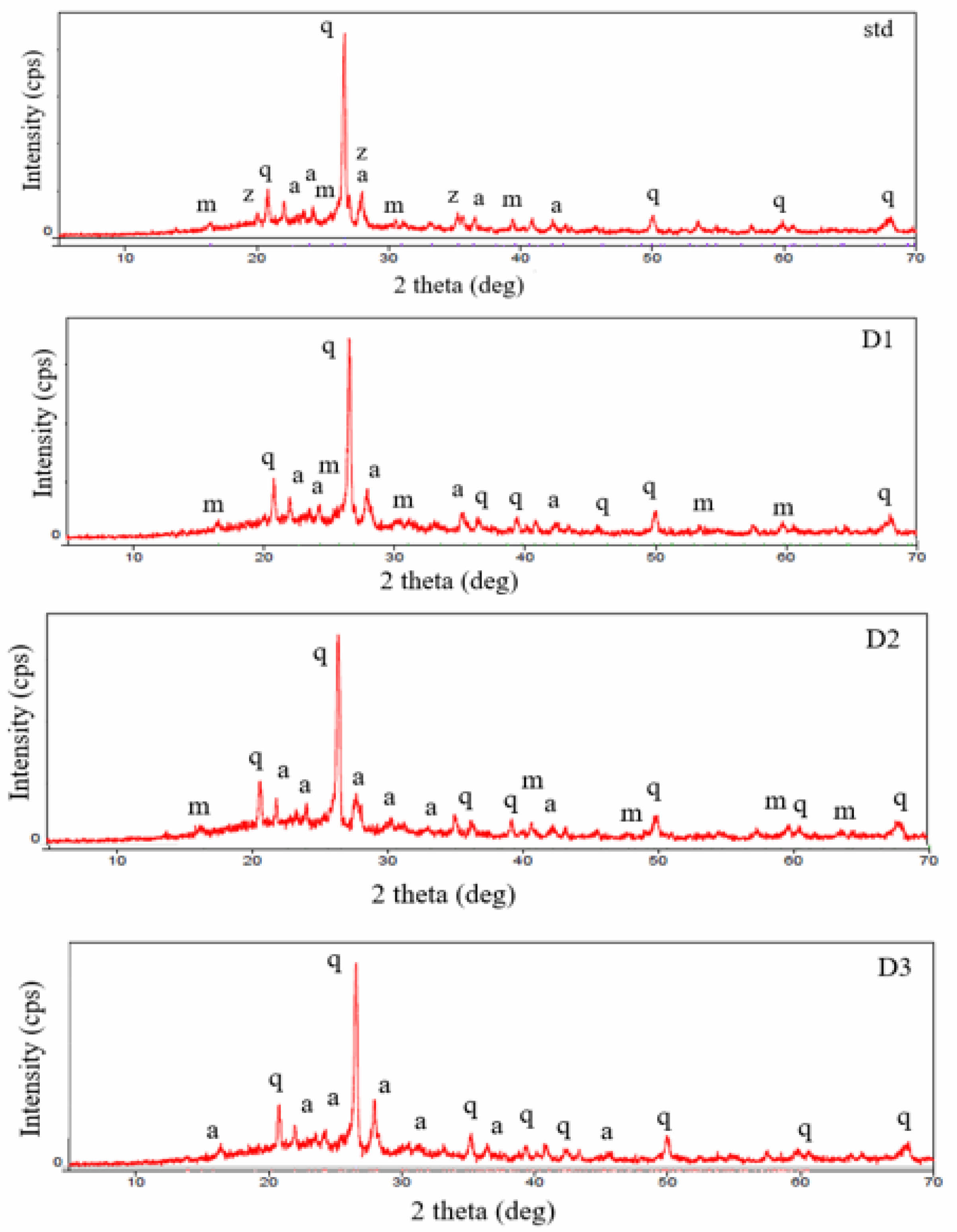
|
Fig. 5 XRD graphs of standard floor tile and D1-D3 samples (a: albite, m: mullite, q: quartz). |
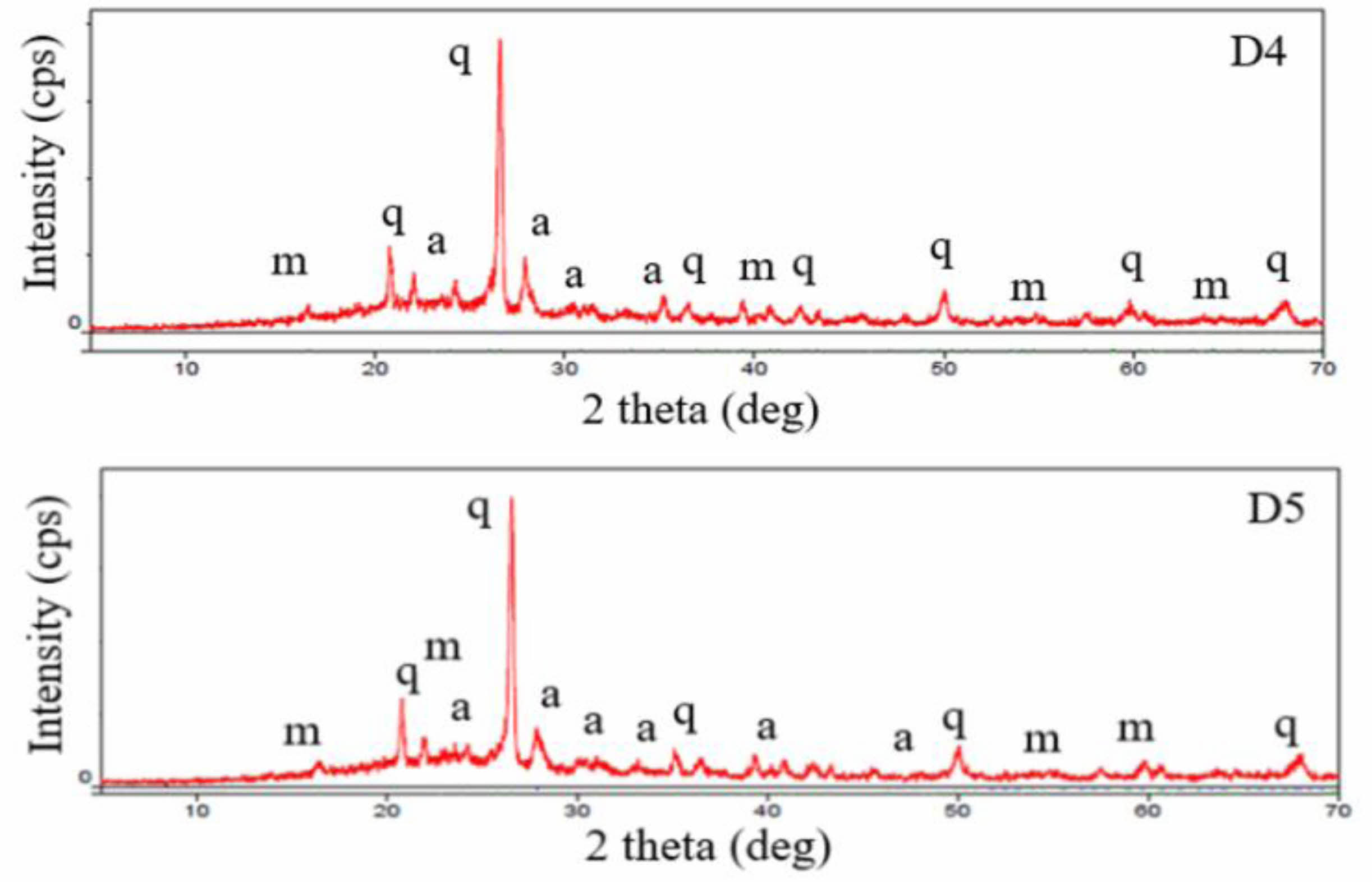
|
Fig. 6 XRD graphs of standard floor tile and D4 and D5 samples (a: albite, m: mullite, q: quartz). |
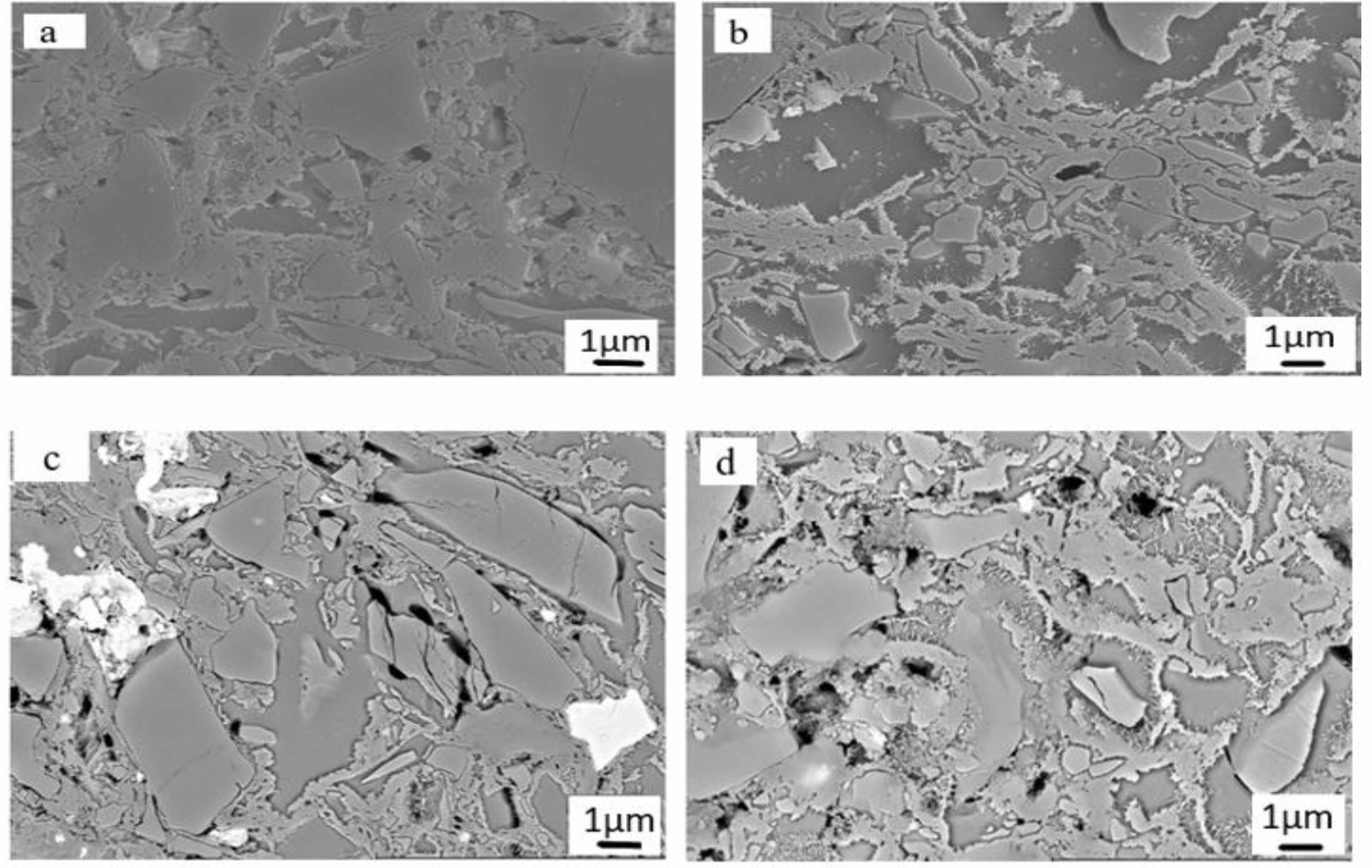
|
Fig. 7 SEM images of the selected samples a) Std, b) D1, c) D2, d) D4. |
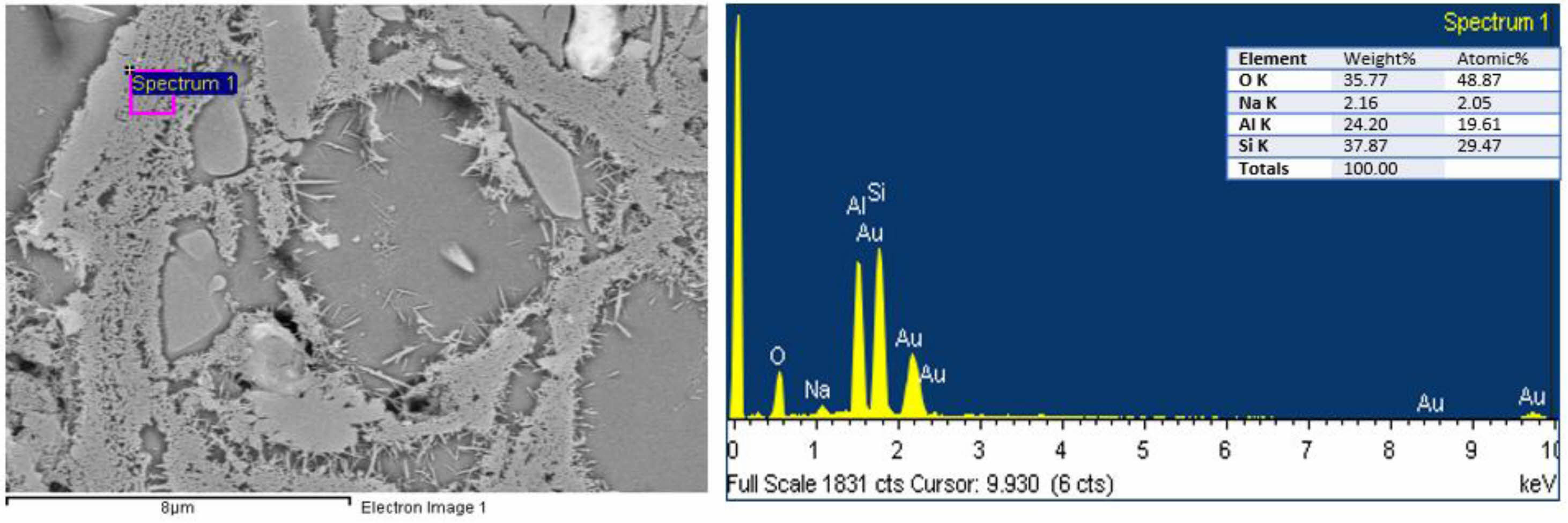
|
Fig. 8 SEM-EDS analysis image of standard floor tile. |

|
Fig. 9 SEM-EDS analysis image of D1. |

|
Fig. 10 SEM-EDS analysis image of D2. |

|
Fig. 11 SEM-EDS analysis image of D4. |
This study investigates the viability of incorporating waste zirconia nozzles from the Bilecik Iron and Steel Company (Bilecik, Turkey) into the production of floor tile bodies. The research encompasses comprehensive experimental investigations and analyses, including a comparative assessment of color properties between standard zircon raw materials and waste zirconia. Different combinations of waste zirconia were integrated into the ceramic tile formulation, utilizing raw materials known for their distinctive color attributes. Following the requisite processing steps, the formulated recipes underwent firing in an industrial kiln, followed by initial assessments of their physical and mechanical properties. The experiment demonstrates that incorporating 2 % wt. nozzle waste into ceramic floor tiles enhances both their whiteness and firing strength. Notably, the microstructure of these new waste-based samples reveals more prominent mullite needles, with crystal phase analyses closely resembling those of standard floor tiles. This phenomenon accounts for the observed strength improvement. Consequently, the incorporation of waste nozzles as a source of zircon oxide in tile composition shows promising potential for enhancing both strength and wear resistance. This innovative approach offers a sustainable solution while maintaining key properties such as shrinkage and water absorption within acceptable standards. By harnessing the benefits of waste materials, we can not only improve the performance of tiles but also contribute to environmentally conscious practices within the ceramic industry. This underscores the importance of continued exploration and implementation of alternative materials for sustainable development in the construction and manufacturing sectors.
Raw materials, industrial standard test applications and laboratory facilities were supported by the Seranit Ceramic Company (Bilecik/Turkey), and waste zirconia nozzles were supported by Bilecik Demir Celik Tic. Company (Bilecik, Turkey).
- 1. Web site 1: https://constrofacilitator.com/ceramic-tiles-for-functional-and-aesthetic-performance/ (Accessed 1 December 2023)
- 2. Web site 2: https://www.linkedin.com/pulse/benefits-using-tiles-commercial-spaces-tieic-group (Accessed 1 December 2023)
- 3. Web site 3:https://www.uniquetiles.com/the-history-of-ceramic-tiles-you-should-know(Accessed 1 December 2023)
- 4. Web site 4:https://www.traditionalbuilding.com/product-report/ceramic-tile-history(Accessed 1 December 2023)
- 5. H. Celik, Appl. Clay Sci. 50[2] (2010) 245-249.
-

- 6. A.C.S. Alcantara, M.S.S. Beltrao, H.A. Oliveira, I.F. Gimenez, and L.S. Barreto, Appl. Clay Sci. 39[3-4] (2008) 160-165.
-

- 7. Z. Bayer Ozturk, J. Aust. Ceram. Soc. 53 (2017) 101-107.
-

- 8. C. Gol, “Production of Ceramic Tiles by Using Marine Sludge Additives”, Master of thesis, Department of Chemical Engineering, Izmir Institute of Technology, Izmir, Turkey (2006).
- 9. N.M. Khalil, M.M.S. Washsh, and A. Gaberb, J Ceram. Process. Res. 17[5] (2016) 478-484.
-

- 10. G. Binal and N. Ay, J Ceram. Process. Res. 15[2] (2014) 107-111.
-

- 11. D.D. Furszyfer Del Rio, B.K. Savacool, A.M. Foley, S. Griffiths, M. Bazilian, J. Kim, and D. Rooney, Renew. Sust. Energ. Rev. 157 (2022) 112081.
-

- 12. A.W.Vieira, L.S. Rosso, A. Demarch, D. Pasini, S.P. Ruzza, S. Arcaro, M.J. Ribeiro, and E. Angioletto, J. Mater. Res. Tech. 23 (2023) 3904-3915.
-

- 13. Z. Bayer Ozturk, Y. Karaca, B. Kayalı, and E. Ubay, Int. J. Environ. Sci. Technol. 20 (2023) 6307-6318.
-

- 14. A.M.E. Khalil, A.P.M. Velenturf, M. Ahmadinia, and S. Zhang, Sustain. 15[16] (2023) 12230.
-

- 15. Z. Bayer Ozturk, J. Ceram. Process. Res. 17[6] (2016) 555-559.
-

- 16. Y. Karaca, Z. Bayer Ozturk, and E. Ubay, Int. J. Eng. Res. Dev. 15[2] (2023) 872-880.
-

- 17. R.K. Goyal, V. Agarwal, R. Gupta, K. Rathore, and P. Somani, Mater. Today-Pro. 49[5] (2022) 1769-1775.
-

- 18. G.A. Dino and M.A. Fornaro, J. Geo. Res. 452950 (2012) 1-11.
-

- 19. A.P. Luz and S. Ribeiro, Ceram. Int. 33[5] (2007) 761-765.
-

- 20. M. Liu, G. Ma, X. Zhang, J. Liu, and Q. Wang, Mater. 13[3] (2020) 776.
-

- 21. Z. Bayer Ozturk and E. Eren Gultekin, Ceram. Int. 41[9] (2015) 12020-12026.
-

- 22. Z. Bayer Ozturk, K. Pekkan, E. Tasci, and S. Yilmaz, J. Aust. Ceram. Soc. 56 (2020) 609-617.
-

- 23. I. Ozkan, Acta Phys. Pol. A 132 (2017) 427-429.
-

- 24. I. Ozkan, M. Colak, and R.E. Oyman, Appl. Clay Sci. 49[4] (2010) 420-425.
-

- 25. C. Zanelli, S. Conte, C. Molinari, R. Soldati, M. Dondi, and M. Resour, Conserv. Recy. 168 (2021) 105289.
-

- 26. L.N. Khanlar, A.S. Rios, A. Tahmaseb, and A. Zandinejad, Dent. J (Basel). 9[9] (2021) 104.
-

- 27. Web site 5: https://www.zen-ceramic.com/zirconia-ceramics/zirconia-ceramic-nozzles-and-rods.html (Accessed 1 December 2023)
- 28. Web site 6: http://www.zirconianozzle.com/en/product.html (Accessed 1 December 2023)
- 29. Web site 7: https://www.earthwaterfire.com/products/zirconia-ceramics/ (Accessed 1 December 2023)
- 30. G. Karakedi Sakarya, A.O. Berberoglu, O.H. Sakarya, U. Cengiz, and E. Ubay, J. Sci. Kocaeli U. 5[1] (2022) 25-31.
-

- 31. K. Wisniewska, D. Madej, and J. Szczerba, J. Ceram. Sci. Tech. 9[3] (2018) 301-308.
-

- 32. N. Selli, Ceram. Int. 41[6] (2015) 7790-7795.
-

- 33. Web site 8: https://www.zircon-association.org/ceramics.html (Accessed 1 December 2023)
- 34. G. Topates, B. Tarhan, and M. Tarhan, Ceram. Int. 43[15] (2017) 12333-12337.
-

- 35. Web site 9: https://www.preciseceramic.com/blog/zirconium-oxide-ceramic-its-uses.html (Accessed 1 December 2023)
- 36. M. Tarhan, J Therm. Anal. Calorim. 138 (2019) 929-936. https://doi.org/ 10.1007/s10973-019-08268-8
-

- 37. Web site 10: https://nature.berkeley.edu/classes/eps2/wisc/ri.html (Accessed 1 December 2023)
 This Article
This Article
-
2025; 26(1): 43-50
Published on Feb 28, 2025
- 10.36410/jcpr.2025.26.1.43
- Received on Sep 3, 2024
- Revised on Dec 16, 2024
- Accepted on Dec 16, 2024
 Services
Services
- Abstract
introduction
experimental
results and discussions
conclusions
- Acknowledgements
- References
- Full Text PDF
Shared
 Correspondence to
Correspondence to
- Zahide Bayer Ozturk
-
Department of Metallurgy and Materials Engineering, Nevsehir Haci Bektas Veli University, 50300, Nevsehir, Turkey
Tel : +90 384 228 10 00 Fax: +90 384 228 11 23 - E-mail: z.ozturk@nevsehir.edu.tr








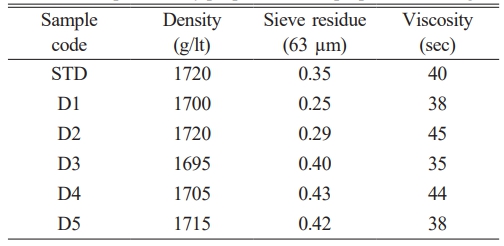

 Copyright 2019 International Orgranization for Ceramic Processing. All rights reserved.
Copyright 2019 International Orgranization for Ceramic Processing. All rights reserved.